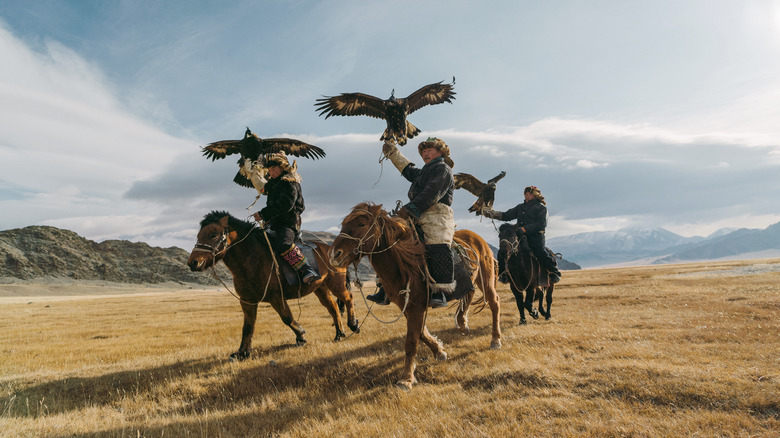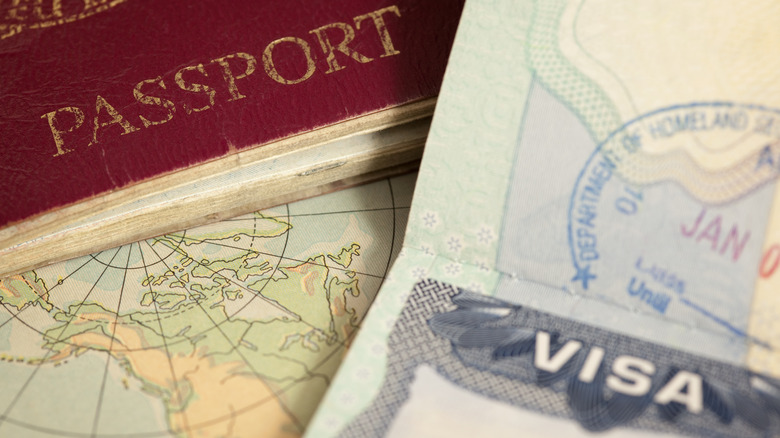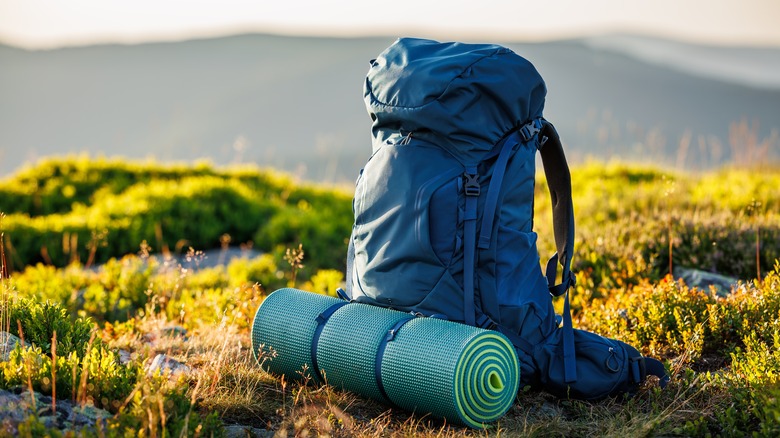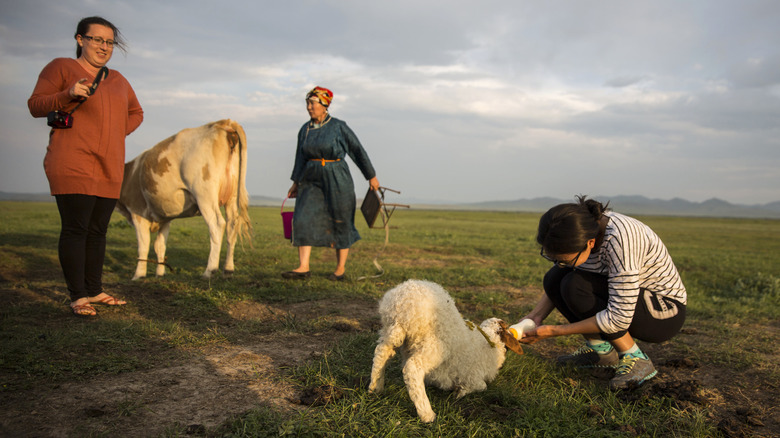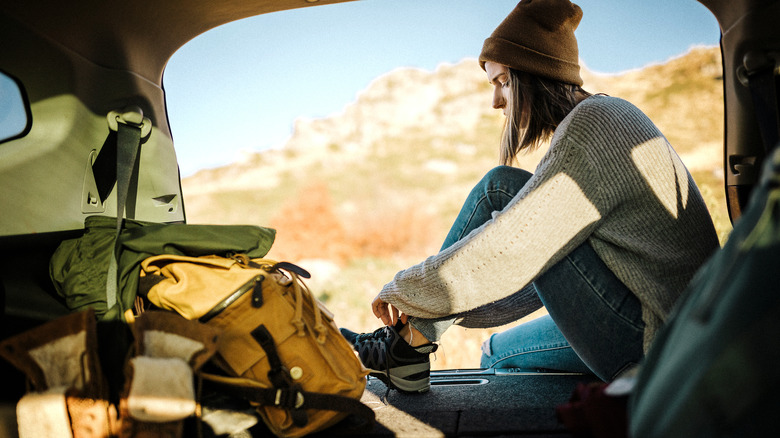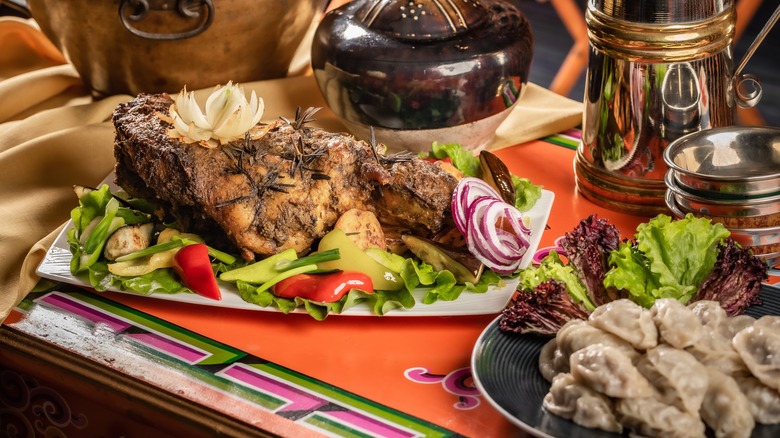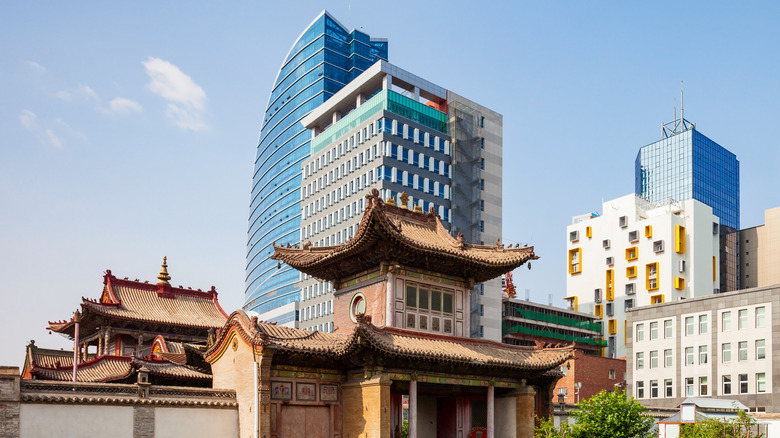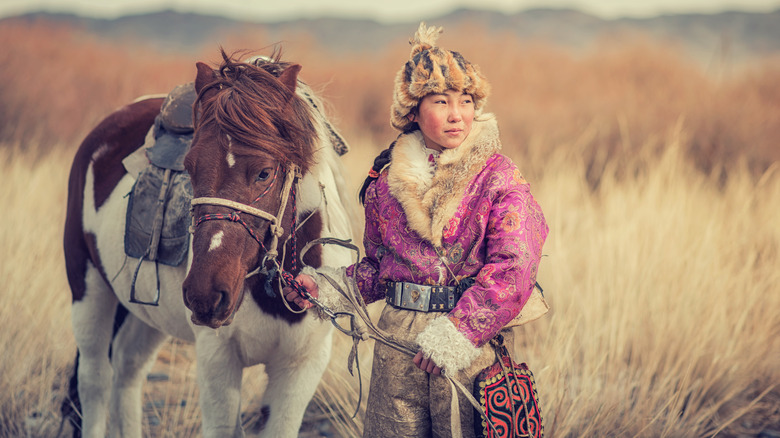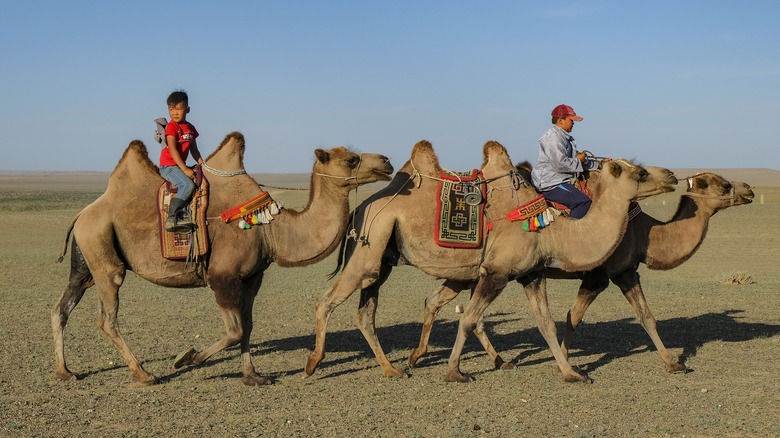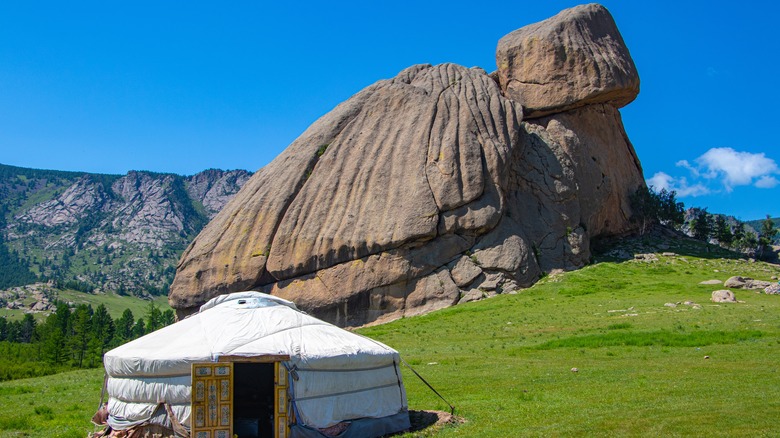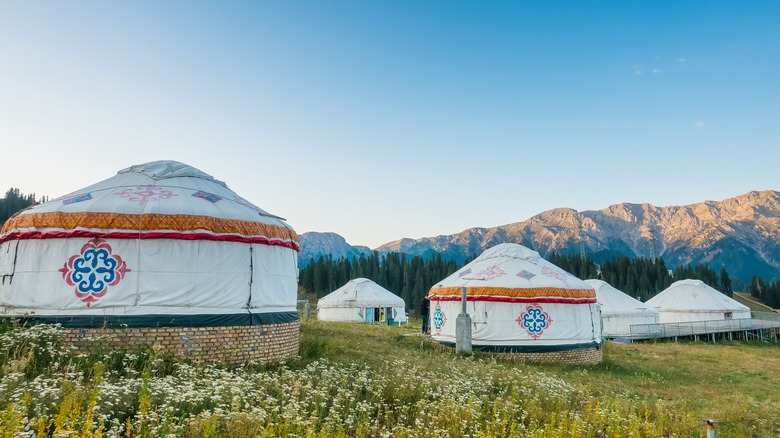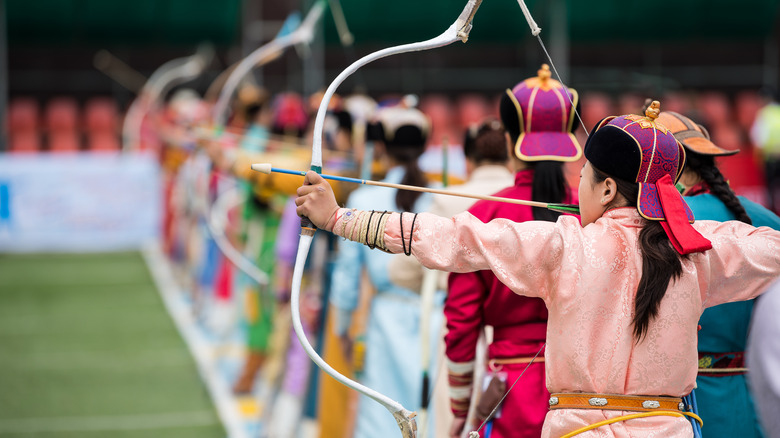11 Things To Know Before Visiting Mongolia
In a remote corner of Asia, sandwiched between China and Russia, is a fiercely independent, ancient land called Mongolia. The "Land of the Eternal Blue Sky," so named because its arid climate keeps it sunny about 250 days of the year, is an explosion of every color, from the green of the vast steppes to the pink of the windflowers and the gold of the ancient Buddhist shrines on white, snowy mountains. Increasing numbers of travelers are drawn to the wide-open spaces of one of the least densely-populated sovereign countries on Earth, where they can stay in a yurt with eagle tamers and yak herders or trace the path of Genghis Khan or Marco Polo atop a semi-wild horse.
Traveling to this breathtakingly unique step back into history isn't quite as straightforward as a jaunt to Paris or Cancún. Once we get a few logistical tips out of the way, we'll give you a tantalizing glimpse into one of the planet's most mysterious and thrilling locales.
Know the visa requirements
First things first: How long can you stay without a visa? If you're an American citizen, you can stay up to 90 days, but make sure your passport is valid at least six months after the date of arrival. If you plan to stay longer than 30 days, register with Mongolian Immigration within seven days of arrival or risk a fine of up to $300. After 90 days, visas are only granted for business, diplomacy, study, and various other non-tourist categories.
Many other nationalities will only have 30 days to stay in Mongolia before they'll need to apply for a visa. Those include most other countries, including Canada, Australia, New Zealand, Germany, Japan, the United Kingdom, France, and more. Before 2023, Mongolia required nationals of many of those countries, including France and the UK, to possess special diplomatic passports to enter. In January 2023, the Mongolian government declared 2023-25 "Years to Visit Mongolia" and allowed citizens of 34 countries to visit for up to 30 days under any official passport.
Travel in the summer, but pack for all seasons
Mongolia is a landlocked country with a climate categorized as "extreme continental." That means it can get very hot — up to 104 degrees Fahrenheit — in the summer and very cold — down to minus 40 degrees Fahrenheit — in the winter. As long as you don't spend too much time in the Gobi Desert, most experts recommend traveling in the summer, when all the festivals occur and the countryside is lush and green. Highs in Ulaanbaatar average around 75 degrees Fahrenheit from June to August. Others recommend visiting in May and September when highs are around 64 degrees Fahrenheit, crowds are smaller, and prices are lower.
That said, you never quite know what you're going to get, especially at night in the steppes, valleys, and deserts. Temperatures can still drop to 40 degrees Fahrenheit at night in July and August, and the country's fierce winds are legendary. What's more, temperatures are known to change in a matter of minutes. No matter when you visit, pack for all seasons (yes, that means a jacket and gloves even in the summer), and make sure to bring a windbreaker. But also bring sunglasses, sunscreen, lots of water, and high-quality camping gear. Ulaanbaatar, the capital, has plenty of outdoor clothing and equipment stores, so you're covered if you forget anything.
Consider getting a tour guide
Mongolia is the 20th largest country on Earth by area, but it's also the most sparsely populated sovereign nation. It's only just opening up to tourism, and vast swaths of the land lack paved roads, electricity, plumbing, or English-speaking locals. For many visitors, that means that the easiest way to explore as much of the list below as possible is to book a reputable tour guide. Tours can last from a single afternoon in a particular spot to a three-week odyssey across the country.
Most tour companies offer some version of a "Top Hits"-style tour that guides visitors through Mongolia's most popular attractions, including staying in a yurt, riding horses, attending festivals, and visiting mountains, forests, and temples. They also offer more specialized tours that include touring through nomadic communities nationwide, visiting reindeer herders in the north, staying with Kazakh eagle hunters, or meeting the competitors of the Naadam Festival. If you want to mix and match all these experiences, you'll probably be able to, as many tour companies allow custom tours.
Prepare if you want to go it alone
All that said, if you're traveling to Mongolia at all, you're probably an adventurous spirit allergic to anything even close to a coach bus full of cameras and fanny packs. However, if you want to plan your own trip through the country and leave the comforts of Ulaanbaatar, be sure to spend a long time preparing, even if you just plan to drive.
It's best to approach the preparation as you would to any remote wilderness. Bring camping gear, a First Aid kit, a hefty supply of non-perishable foods, and filtered water. Bring water purification tablets just in case, and hydrate a lot: Much of the country is very dry, and dehydration can hit unsuspecting travelers. Don't forget medications, particularly if you have pollen allergies.
Rent a sturdy four-wheel drive vehicle that can travel on unpaved roads, and get a few spare tires. Think of every travel insurance policy you can, then get another one. It's best to drive in either June or September since the grass of the steppes can be waterlogged in July or August. Cell service is unreliable in the wilderness, so map out your trip beforehand and get a GPS tracker that will allow a support office in Ulaanbaatar to locate you if you run into trouble. And just like any good road trip, stock up on downloaded podcasts, music, audiobooks, and actual books. One book to remember is a Mongolian phrasebook: Outside Ulaanbaatar, not everyone speaks English.
Address dietary needs beforehand
Mongolia is a carnivore's paradise and a vegetarian's surmountable challenge. Much of the country makes a living through herding, so many animals eventually end up on plates. Staples of the Mongolian diet include mutton, beef, goat, horse, and camels. Meat finds its way into most dishes, whether it's inside steamed dumplings (buuz), fried dumplings (khuushuur), stir fry (tsuivan), or the iconic Mongolian barbecue (khorkhog).
Milk is equally popular, and some popular local dishes include aaruul (made from boiled yogurt), airag (a slightly alcoholic beverage made from fermented mare's milk), or khoormog, which is yogurt made from camel milk.
The standard local diet can present a challenge if you're a vegetarian, lactose intolerant, or kosher. What's more, if you plan to stay with nomads, it is considered disrespectful not to eat the food they cook for you. Make sure to communicate any dietary preferences with your tour guide ahead of time so you can plan the trip accordingly. When you start your trip in Ulaanbaatar, go to supermarkets and stock up on nonperishable foods you can bring with you on the rest of the trip. The capital city also boasts a range of international restaurants, including some vegan spots that serve plant alternatives to traditional Mongolian cuisine.
Start in Ulaanbaatar
No matter where you're coming from, chances are you'll land in Ulaanbaatar, Mongolia's thriving capital of around 1.5 million people. Nearly half the country lives here, and it shows — there are gleaming skyscrapers, fancy hotels, restaurants from all over the world, jazz clubs, opera, and even standup comedy in English. As mentioned, if you plan to head out into the wilderness, you can stock up on whatever you need here.
The city is a destination unto itself, and it's best to give yourself a few days to enjoy its treasures. As a former Buddhist monastic center, Ulaanbaatar is a garden of breathtaking monasteries and temples, including the Gandan Khiid Monastery, which boasts an 86-metre-high statue of Avalokitesvara, the tallest indoor statue in the world, the Choijin Loma Temple Museum, the active Gandantegchilen Monastery, and many more. As a long-time seat of power, it is home to the grand Bogd Khan Winter Palace Museum, once home to a powerful Tibetan monk who ruled Mongolia at the turn of the 20th century.
You can learn all about Mongolia's past and present by visiting Sükhbaatar Square, home to the State Parliament House and a large statue of the infamous conqueror Genghis Khan nearby. The National Museum of Mongolia houses over 50,000 historical objects from the Neolithic era to the present, while the Mongolian National Library houses over 3 million books, many of which are ancient Buddhist texts.
Ride a horse through the steppes
Horses are deeply embedded in Mongolian culture. Many infants are taught to ride before they can walk, and horse racing is one of the "Three Manly Sports of Mongolia," alongside archery and wrestling. In the 13th century, Genghis Khan's so-called "Devil Horsemen" created the largest empire in the world thanks largely to their prowess on horseback.
Today, Mongolia's steppes look much the same as they did 700 years ago, and a horse is one of the best ways to experience the vast, empty, windswept fields. Most Mongolian tours will include some form of horseback riding and some multi-day tours are devoted exclusively to crisscrossing the country on horse. At first glance, the steppes may look like big empty fields, but there's a lot there. The trusty steeds can take you to Buddhist monasteries, alongside beautiful lakes and rivers, and into dense forests and mountains. Some tours explicitly allow you to embrace your inner conqueror by following the paths of Genghis Khan and the Golden Horde.
A few things to remember: Most Mongolian horses are considered "semi-wild," so it's best to have some horseback riding experience. Check with your guide beforehand. Mongolians also approach their horses from the left and stand while they're riding them. Don't make any sudden motions, or you may wind up like Joe Biden, who made a gift horse buck when he tried to tie two ceremonial scarves around its neck during a visit to Mongolia in 2011.
Ride a camel through the Gobi
It's a remarkable and rare country that boasts both reindeer and camels. In the country's south, near the border with China, the grassy steppe gradually makes way for the Gobi Desert, which, at 500,000 square miles, is the fifth largest desert in the world. There's no more exciting way to explore the desert than in between the two large humps of a Bactrian camel, a rare breed full of wool and fat that help them withstand the Gobi's extreme temperatures of anywhere from minus 38 to 107 degrees Fahrenheit.
Several tours include leisurely camel treks through the desert's fascinating scenery. Gobi translates to "semi-desert," and it is only five percent sand –- though the 260-feet Khongoryn Sand Dunes are nothing to scoff at. But the Gobi also contains steppes, green valleys, rivers, lakes, and the Flaming Cliffs, the fiery red cliffs where the first known collection of dinosaur eggs was discovered and are still teeming with fossils. You're also likely to spot gazelles, ibex, wild sheep, wolves, foxes, golden eagles, bears, and maybe even snow leopards.
But if camels are your true passion, schedule your trip in March, when the annual Thousand Camel Festival features everything from camel racing to a camel parade to camel polo.
Visit national parks
As you may have guessed, Mongolia is home to a stunningly diverse array of mind-blowing natural wonders. The best way to enjoy as many of them as possible is through visiting some of the country's 99 protection areas, which cover 17.4% of its territory. The first created was Bogd Khan Uul, a 7,400-foot mountain just outside Ulaanbaatar, that was proclaimed one of the world's first protected areas in 1778, over a century before the U.S. named Yellowstone its first national park. Today, the mountain offers panoramic views of the city alongside forests, streams, flowers, birds, and even ski and golf resorts.
About two hours east of Ulaanbaatar is Gorkhi-Terelj, a grassy paradise teeming with multicolored wildflowers, flowing rivers, elk, moose, bears, and dramatic granite rock formations resembling turtles. The park also features a glacial lake and the Yetsii natural hot springs. Swimmers who don't mind colder water will adore Lake Khövsgöl, one of the country's largest, deepest, purest lakes dotted with four islands. From the glassy, deep blue water or one of the many hiking trails surrounding it, you may observe ibex, bears, or over 250 species of bird.
And if you'd like to climb to the "Top of Mongolia," head to Altai Tavan Bogd National Park, which features Khüiten Uul, the tallest mountain in Mongolia at 14,291 feet above sea level. Just for good measure, the park includes four other towering peaks, two beautiful lakes, glaciers, waterfalls, and eagle hunters.
Stay in a ger
No trip to Mongolia is complete without a stay inside the iconic ger tent, more commonly known in the West as a yurt. A ger typically contains two elaborately decorated beds, a central wood-burning stove, a shrine, and, increasingly often, modern conveniences like a satellite dish, solar panels, or charging outlets.
Over half the country's population lives in these lightweight, portable, circular tents, including in Ulaanbaatar. In the countryside, that expands to nearly 90%. Travelers can opt to stay at a ger camp, which is often a cluster of 30 or more tents geared toward tourists. The camps often have toilets, showers, electricity, and a central restaurant.
You can also book a homestay with a nomadic family, which is most often organized through a tour company. In addition to spending the night, you'll also be able to observe a slice of Mongolian life as you shadow the family through their daily tasks, whether it's milking a yak or herding cattle. At night, you'll join several generations enjoying a communal meal together. All good ger guests should remember a few etiquette rules in mind and confer with your guide beforehand. It's customary to bring gifts and eat all the food you're given. Enter through the left and sit down immediately, but wait until you've been served tea to begin talking. Don't lean against the walls, don't throw trash into the fire, and accept everything with your right hand.
Attend traditional festivals
Would you rather watch an eagle swooping down to catch a fox, a five-year-old riding a horse before of a cheering crowd, or wrestling on top of a frozen lake? Or, as mentioned earlier, camel polo? Mongolia is famous for its many festivals, which often combine outstanding athleticism with incredible animals, music, dance, food, and traditional costumes. They take place at different points in the year, but no trip to the country is complete without catching at least one.
The most high-profile is the Naadam Festival in July, which is something like the country's own Olympic games. The festival begins with a dazzling, televised opening ceremony in Ulaanbaatar, awash with music, dance, pageantry, and color. Sites across the country host competitions in each of the "Three Manly Sports": wrestling, archery (open to men and women, despite the aforementioned moniker), and horseback riding (open to children as young as five.)
In October, head to western Mongolia for the Golden Eagle Festival, where ethnic Kazakh eagle hunters compete to see whose birds catch the most prey with the most precision and speed. March sees the Thousand Camel Festival, which shows that any competition you can have on a horse can also be held atop a camel.
If you prefer a more non-competitive — and chilly — vibe, come in February for Tsagaan Sar, the Mongolian Lunar New Year, where you'll celebrate the New Year with a traditional feast of dumplings, mutton, horse, rice, cookies, and airag.
